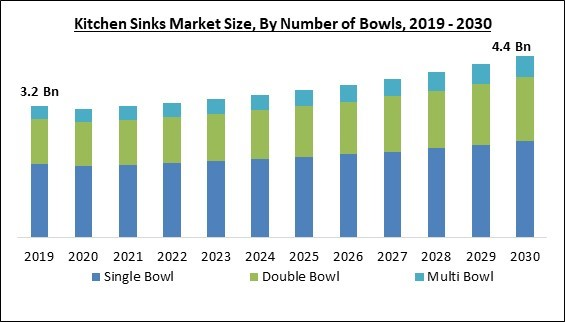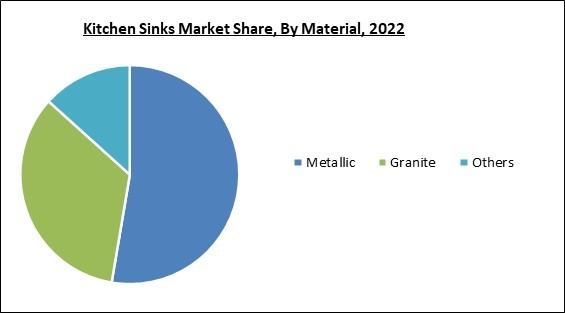The Global Kitchen Sinks Market size is expected to reach $4.4 billion by 2030, rising at a market growth of 3.9% CAGR during the forecast period. In the year 2022, the market attained a volume of 14,855.8 thousand units, experiencing a growth of 2% (2019-2022).
Rising residential and commercial building construction is driving the need for metallic kitchen sinks, therefore, the metallic material would capture approximately half of the share of the market by 2030. For example, by 2050, 68% of the world’s population, or more than half of total population, will reside in urban areas. According to projections, 2.5 billion more people could live in urban areas by 2050 as a result of urbanization, which is the gradual movement of people from rural to urban areas. Nearly 90% of this increase would occur in Asia and Africa, according to a new United Nations data set released in 2018. With this growing urbanization, there will be a considerable increase in construction activities all over the world. More advanced construction techniques, expert designs, and technologies are becoming more popular in smart homes to attract more consumers, which will drive the technology-driven kitchen sinks, thereby supporting the market growth. Some of the factors impacting the market are integration of technology in kitchen sinks, increased spendings in kitchen aesthetics, and increase in stainless steel prices.
Due to the development of electronics and communication technologies, the demand for smart home appliances is anticipated to experience rapid expansion in the coming years. Global demand for smart home equipment has increased as a result of changing lifestyles and rising purchasing power. Smart home appliances would become increasingly prevalent as they enable real-time communication to operate the product at low frequencies or modify the operations time to off-peak periods. The smart sink is one of the modern kitchen appliances. Additionally, the kitchen is increasingly considered an essential area in the perspective of modern consumers; rather, it is now seen as being more crucial to maintaining an organized and appealing home. People prefer smart home technologies and user-friendly kitchen appliances increasingly as a result since they can satisfy their demands and are not limited in the same way that conventional kitchen sinks are in terms of use and aesthetic appeal. Thus, it is anticipated that the market for kitchen skin will expand due to the advanced technologies for kitchen appliances and due to the rise in consumers’ willingness to spend on aesthetic kitchen fixtures, the market for kitchen sinks is estimated to encounter growth prospects in the near future.
However, low-carbon steel is a material that is referred to as stainless steel. It does not rapidly corrode, rust, or get stained with water like conventional steel. Due to the addition of various alloying elements like iron, chromium, nickel, manganese, and copper, stainless steel is more expensive. About 10% chromium is also added by the manufacturers to the steel as a corrosion-resistant additive. Stainless steel's resistance to corrosion is further increased because it is non-porous. The grade and surface finishes of the stainless steel that are created to suit the environment to which the material will be exposed additionally impact the cost of production. The price of kitchen sinks will increase along with the high cost of stainless steel, negatively impacting the market.
The market research report covers the analysis of key stake holders of the market. Key companies profiled in the report include Kohler Co., Frigidaire Appliance (AB Electrolux), American Bath Group, Acrysil Ltd. (Carysil Ltd.), The MiddleBy Corporation, Duravit AG, Dornbracht Deutschland GmbH & Co. KG, Ruvati USA, Roca Sanitario, SA (Roca Corporacion Empresarial, SA) and Zuhne.
Rising residential and commercial building construction is driving the need for metallic kitchen sinks, therefore, the metallic material would capture approximately half of the share of the market by 2030. For example, by 2050, 68% of the world’s population, or more than half of total population, will reside in urban areas. According to projections, 2.5 billion more people could live in urban areas by 2050 as a result of urbanization, which is the gradual movement of people from rural to urban areas. Nearly 90% of this increase would occur in Asia and Africa, according to a new United Nations data set released in 2018. With this growing urbanization, there will be a considerable increase in construction activities all over the world. More advanced construction techniques, expert designs, and technologies are becoming more popular in smart homes to attract more consumers, which will drive the technology-driven kitchen sinks, thereby supporting the market growth. Some of the factors impacting the market are integration of technology in kitchen sinks, increased spendings in kitchen aesthetics, and increase in stainless steel prices.
Due to the development of electronics and communication technologies, the demand for smart home appliances is anticipated to experience rapid expansion in the coming years. Global demand for smart home equipment has increased as a result of changing lifestyles and rising purchasing power. Smart home appliances would become increasingly prevalent as they enable real-time communication to operate the product at low frequencies or modify the operations time to off-peak periods. The smart sink is one of the modern kitchen appliances. Additionally, the kitchen is increasingly considered an essential area in the perspective of modern consumers; rather, it is now seen as being more crucial to maintaining an organized and appealing home. People prefer smart home technologies and user-friendly kitchen appliances increasingly as a result since they can satisfy their demands and are not limited in the same way that conventional kitchen sinks are in terms of use and aesthetic appeal. Thus, it is anticipated that the market for kitchen skin will expand due to the advanced technologies for kitchen appliances and due to the rise in consumers’ willingness to spend on aesthetic kitchen fixtures, the market for kitchen sinks is estimated to encounter growth prospects in the near future.
However, low-carbon steel is a material that is referred to as stainless steel. It does not rapidly corrode, rust, or get stained with water like conventional steel. Due to the addition of various alloying elements like iron, chromium, nickel, manganese, and copper, stainless steel is more expensive. About 10% chromium is also added by the manufacturers to the steel as a corrosion-resistant additive. Stainless steel's resistance to corrosion is further increased because it is non-porous. The grade and surface finishes of the stainless steel that are created to suit the environment to which the material will be exposed additionally impact the cost of production. The price of kitchen sinks will increase along with the high cost of stainless steel, negatively impacting the market.
Number of Bowls Outlook
By number of bowls, the market is fragmented into single bowl, double bowl, and multi bowl. The double bowl segment garnered a significant revenue share in the market in 2022. Many lodging facilities, restaurants, and companies prefer double-bowl sinks. Consumers usually fill one dish with soapy liquid and rinse the utensils in the other to speed up and simplify the cleaning procedure. Manufacturers have been developing creative solutions because double-bowl sinks take up more space, including two units with one sink shallower than the other or one shallow sink to fit smaller utensils.Material Outlook
Based on material, the market is segmented into metallic, granite, and others. In 2022, the metallic segment dominated the market with the maximum revenue share. These sinks are available in various metals, including copper, cast iron, and stainless steel. The most common kitchen sinks are made of stainless steel, which has several advantages, such as a superior strength-to-weight ratio, ease of manufacturing, antibacterial properties, long-term value, and resistance to corrosion, fire, heat, and impact. Several techniques exist to install metallic sinks, including under mount and top mount.Regional Outlook
Region wise, the market is analyzed across North America, Europe, Asia Pacific, and LAMEA. In 2022, the Asia Pacific region registered the highest revenue share in the market. Home transforming initiatives have been fueled by the rapid urbanization of developing nations and rising disposable income levels. A rise in social events like house parties and family reunions also fuels the demand for home improvement. New designs and kitchen sinks in various colors, sizes, functionalities, and textures have flooded the market in the region.The market research report covers the analysis of key stake holders of the market. Key companies profiled in the report include Kohler Co., Frigidaire Appliance (AB Electrolux), American Bath Group, Acrysil Ltd. (Carysil Ltd.), The MiddleBy Corporation, Duravit AG, Dornbracht Deutschland GmbH & Co. KG, Ruvati USA, Roca Sanitario, SA (Roca Corporacion Empresarial, SA) and Zuhne.
Scope of the Study
By Number of Bowls (Volume, Thousand Units, USD Million, 2019-2030)
- Single Bowl
- Double Bowl
- Multi Bowl
By Material (Volume, Thousand Units, USD Million, 2019-2030)
- Metallic
- Granite
- Others
By Geography (Volume, Thousand Units, USD Million, 2019-2030)
- North America
- US
- Canada
- Mexico
- Rest of North America
- Europe
- Germany
- UK
- France
- Russia
- Spain
- Italy
- Rest of Europe
- Asia Pacific
- China
- Japan
- India
- South Korea
- Singapore
- Malaysia
- Rest of Asia Pacific
- LAMEA
- Brazil
- Argentina
- UAE
- Saudi Arabia
- South Africa
- Nigeria
- Rest of LAMEA
Key Market Players
List of Companies Profiled in the Report:
- Kohler Co.
- Frigidaire Appliance (AB Electrolux)
- American Bath Group
- Acrysil Ltd. (Carysil Ltd.)
- The MiddleBy Corporation
- Duravit AG
- Dornbracht Deutschland GmbH & Co. KG
- Ruvati USA
- Roca Sanitario, SA (Roca Corporacion Empresarial, SA)
- Zuhne
Unique Offerings
- Exhaustive coverage
- The highest number of Market tables and figures
- Subscription-based model available
- Guaranteed best price
- Assured post sales research support with 10% customization free
Table of Contents
Chapter 1. Market Scope & Methodology
Chapter 2. Market at a Glance
Chapter 3. Market Overview
Chapter 4. Global Kitchen Sinks Market by Number of Bowls
Chapter 5. Global Kitchen Sinks Market by Material
Chapter 6. Global Kitchen Sinks Market by Region
Chapter 7. Company Profiles
Companies Mentioned
- Kohler Co.
- Frigidaire Appliance (AB Electrolux)
- American Bath Group
- Acrysil Ltd. (Carysil Ltd.)
- The MiddleBy Corporation
- Duravit AG
- Dornbracht Deutschland GmbH & Co. KG
- Ruvati USA
- Roca Sanitario, SA (Roca Corporacion Empresarial, SA)
- Zuhne
Methodology

LOADING...










